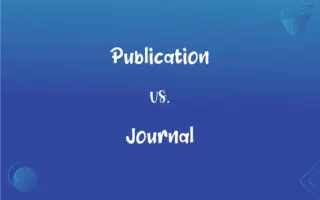Product Layout vs. Process Layout: What's the Difference?
Edited by Janet White || By Harlon Moss || Published on December 13, 2023
Product layout arranges machinery by product sequence, while process layout groups similar activities together.

Key Differences
Product layout, commonly used in mass production, arranges machinery and equipment to focus on sequential production of a particular product. This contrasts with process layout, which groups similar operations together, focusing on a variety of products that require similar processes.
In product layout, the production line is set up in a straight or U-shaped flow to facilitate smooth movement of materials. Process layout, however, involves a more flexible arrangement where similar processes are located together, catering to customized or small batch production.
Product layout is efficient for high-volume, low-variety production, reducing movement and transition time. Conversely, process layout allows for greater flexibility and is suitable for low-volume, high-variety production scenarios.
Product layout often results in lower skill requirements for labor, as the focus is on repetitive tasks. In contrast, process layout may require more skilled labor, as workers may need to perform a variety of tasks.
In product layout, equipment utilization is high, but the system is less adaptable to changes. Process layout offers more adaptability but may result in lower equipment utilization.
ADVERTISEMENT
Comparison Chart
Focus
Sequential production of specific products
Grouping of similar processes
Layout Structure
Linear or U-shaped, focusing on product flow
Flexible, centered around process similarities
Volume and Variety
High volume, low variety
Low volume, high variety
Labor Requirements
Lower skill level for repetitive tasks
Higher skill level for diverse tasks
Adaptability
Less adaptable to changes
More adaptable to product changes
ADVERTISEMENT
Equipment Utilization
High utilization
Variable, often lower than product layout
Product Layout and Process Layout Definitions
Product Layout
It is suited for mass production of standardized products.
Electronics assembly lines use a product layout for consistent production of identical gadgets.
Process Layout
Process layout groups similar operations together regardless of the product.
A machine shop arranges all drilling machines in one area, exemplifying process layout.
Product Layout
Product layout involves dedicated equipment for each product line.
A newspaper printing press utilizes a product layout, dedicating machinery to each printing stage.
Process Layout
It is designed for small-batch, custom products requiring different processes.
A custom furniture workshop uses a process layout to accommodate varied crafting processes.
Product Layout
This layout type minimizes material movement and transition time.
In a cookie factory, a product layout ensures continuous flow from dough mixing to packaging.
Process Layout
This layout offers flexibility for a variety of products and changes.
A multi-specialty clinic, with different rooms for various treatments, adopts a process layout.
Product Layout
Product layout arranges resources based on the sequence of product assembly.
Car manufacturing plants often use a product layout for efficient assembly line production.
Process Layout
Process layout is characterized by variable equipment utilization.
In a print shop, different machines are used variably depending on the custom orders, reflecting a process layout.
Product Layout
It is a linear arrangement of machinery aligned with the production process.
A bottling plant uses a product layout to streamline the filling, capping, and labeling process.
Process Layout
It requires skilled labor capable of handling diverse tasks.
An artisan bakery employs a process layout, with bakers skilled in various baking techniques.
FAQs
What kind of products suit process layout?
Custom or varied products requiring different processes.
Where is product layout commonly used?
In industries with mass production like automobile manufacturing.
How does product layout affect labor skills?
It often requires lower skill levels due to repetitive tasks.
What is product layout?
It's an arrangement of resources based on product assembly sequence.
Is product layout adaptable to changes?
It's less adaptable compared to process layout.
Can process layout handle high volume production efficiently?
It's less efficient for high volume compared to product layout.
What is process layout?
It groups together similar operations or processes.
What is a disadvantage of product layout?
Reduced flexibility for product changes.
Is product layout cost-effective for small batches?
No, it's more suited for large-scale, repetitive production.
What is a challenge in managing a process layout?
Managing diverse processes and skilled labor requirements.
What is a key benefit of process layout?
Greater flexibility in managing different product types.
How does layout choice affect inventory management?
Product layout leads to streamlined inventory for specific products, while process layout requires diverse inventory management.
Can product layout accommodate different products easily?
No, it's designed for specific, standardized products.
What industries typically use process layout?
Industries like custom furniture making and specialty clinics.
How does product layout impact production speed?
It often increases production speed due to specialized lines.
Is process layout suitable for standardized products?
It's less suitable compared to product layout.
What type of layout is better for rapidly changing markets?
Process layout, due to its adaptability and flexibility.
What type of layout allows for customized production?
Process layout is better for customized production.
How does process layout impact equipment utilization?
It can lead to variable, often lower, equipment utilization.
How does product layout affect product transition time?
It minimizes transition time between production stages.
About Author
Written by
Harlon MossHarlon is a seasoned quality moderator and accomplished content writer for Difference Wiki. An alumnus of the prestigious University of California, he earned his degree in Computer Science. Leveraging his academic background, Harlon brings a meticulous and informed perspective to his work, ensuring content accuracy and excellence.
Edited by
Janet WhiteJanet White has been an esteemed writer and blogger for Difference Wiki. Holding a Master's degree in Science and Medical Journalism from the prestigious Boston University, she has consistently demonstrated her expertise and passion for her field. When she's not immersed in her work, Janet relishes her time exercising, delving into a good book, and cherishing moments with friends and family.






































































